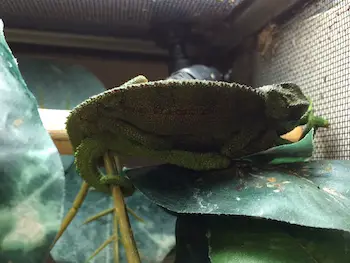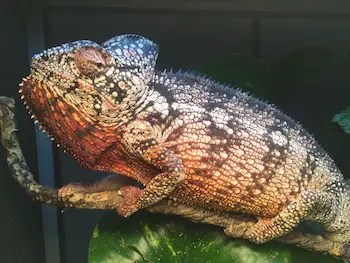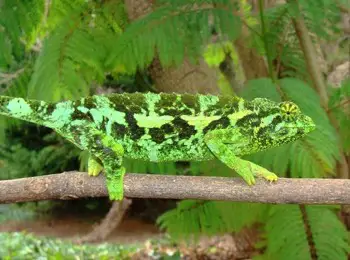Which species of chameleon make the best pets?
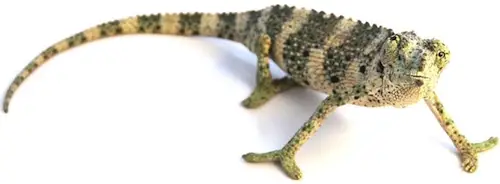
Best Pet Chameleons
Top 5 Best Pet Chameleons
There are around 165 species of chameleon worldwide, but which chameleons make the best pets? There are an overwhelming number of factors to consider, so I’ve compiled a list of what I believe to be the top captive pet chameleons.
I’ve ranked them based upon which species tend to thrive in captivity, while simultaneously making a wonderful pet in terms of interactivity, expected lifespan, ease of feeding, origins, and color.
This list is based upon my experience keeping and caring for thousands of different chameleons over the years, from the common species to the rare. Experience is always the best teacher, and I’ve learned a lot along the way.
There are around 165 species of chameleon worldwide, but which chameleons make the best pets? There are an overwhelming number of factors to consider, so I’ve compiled a list of what I believe to be the top captive pet chameleons.
I’ve ranked them based upon which species tend to thrive in captivity, while simultaneously making a wonderful pet in terms of interactivity, expected lifespan, ease of feeding, origins, and color.
This list is based upon my experience keeping and caring for thousands of different chameleons over the years, from the common species to the rare. Experience is always the best teacher, and I’ve learned a lot along the way.
#5 - Rudis Chameleon (Trioceros rudis/sternfeldi)
These gentle chameleons make excellent pets for a litany of reasons. Their small size makes them extremely manageable, hitting just 5-6 inches in total length. This also means their cage size can be modest—I often use a 16” x 20” screened cage for a pair, a little larger for a trio.
Yes, I’ve found that you can keep pairs and trios together successfully, and it often results in captive breeding and eventual live births, which is always fun! The babies are little replicas of their parents, with the exception of some triangular patterning. When the females are gravid, they look like they’ve been blown full of air.
These gentle chameleons make excellent pets for a litany of reasons. Their small size makes them extremely manageable, hitting just 5-6 inches in total length. This also means their cage size can be modest—I often use a 16” x 20” screened cage for a pair, a little larger for a trio.
Yes, I’ve found that you can keep pairs and trios together successfully, and it often results in captive breeding and eventual live births, which is always fun! The babies are little replicas of their parents, with the exception of some triangular patterning. When the females are gravid, they look like they’ve been blown full of air.
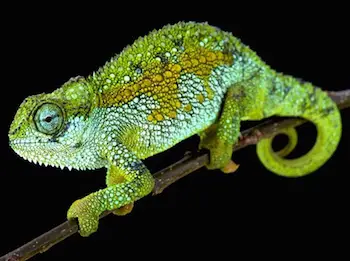
Pet Rudis chameleons are generally very good eaters, quite active, and just plain gorgeous. Their skin has a really neat texture to it too. Both sexes have bright green coloration, and males have yellow markings along their sides as well.
I’ve had great success with this chameleon species in captivity, and I can highly recommend them as a pet chameleon for beginners. It’s worth mentioning that I’ve never seen one attempt to bite, and I’ve handled hundreds of them. I’d recommend 3/8” to 1/2” crickets as the staple food for your Rudis chameleon.
One of the pictures above shows a pair of my Rudis chameleons mating. The female gave a successful live birth several months later. The babies are moderately difficult to raise to adulthood.
#4 - Oustalet’s Chameleon (Furcifer oustaleti)
Oustalet’s make great pet chameleons for a few different reasons, not the least of which being that they are long-lived and tend to thrive in captivity. I briefly review this species on my types of chameleons page, but suffice it to say, they reach really large sizes—it’s even considered a candidate for the longest chameleon in the world, topping-out at around 28-inches.
I’ve found that they’re usually much more colorful than most of the photographs available online, which usually depict them as brown and dull.
The picture below is of my biggest male, who is still growing. You can see he’s got a tremendous amount of reddish orange coloration, and coupled with his large size, means he’s stunning to behold. He’ll also breed on command! They’re named after a French biologist, and it’s pronounced “oo—stuh—lays.”
Oustalet’s make great pet chameleons for a few different reasons, not the least of which being that they are long-lived and tend to thrive in captivity. I briefly review this species on my types of chameleons page, but suffice it to say, they reach really large sizes—it’s even considered a candidate for the longest chameleon in the world, topping-out at around 28-inches.
I’ve found that they’re usually much more colorful than most of the photographs available online, which usually depict them as brown and dull.
The picture below is of my biggest male, who is still growing. You can see he’s got a tremendous amount of reddish orange coloration, and coupled with his large size, means he’s stunning to behold. He’ll also breed on command! They’re named after a French biologist, and it’s pronounced “oo—stuh—lays.”
I’ve noticed a definite correlation between the size of a chameleon, and its lifespan. While this is totally logical, it’s something to keep in mind when selecting your new pet. Generally speaking, the bigger it is, the longer the lifespan, ceteris paribus. The shortest chameleon lifespans I’ve experienced are Pygmy chameleons, which are also the smallest species.
Temperament-wise, I’ve never had an Oustalet’s chameleon attempt to bite me. The females do seem a little more receptive to handling than the males.
Oustalet’s chameleons originally hail from the magnificent island of Madagascar, where they are often found in the drier habitats. I’ve noticed they don’t seek out water as fervently as many other species, which has helped convince me they are just more dry-tolerant. They’re sometimes known as “Malagasy” chameleons. Malagasy also happens to be the national language of Madagascar.
#3 - Jackson’s Chameleon (Chamaeleo jacksoni)
Jackson’s chameleons, with their three distinct horns, are probably the most recognizable pet chameleons in the world. They reach a moderate size, tipping the scales at around 10-12 inches in total length—once in a while I come across one a bit larger. They’re easy to sex because the females don’t have any horns.
These chameleons come in a wide array of colors, with some being green with dark green mottling, some bright green, some more yellowish, some accented with bright yellow crests, and some with blue hues. Most of the pet Jackson’s chameleons available in the U.S. are affordably priced. You can get your own here.
I’ve never been bitten by a Jackson’s, although they do try once in a while if you startle them—but it’s very slow and deliberate, and very easy to avoid.
Jackson’s chameleons, with their three distinct horns, are probably the most recognizable pet chameleons in the world. They reach a moderate size, tipping the scales at around 10-12 inches in total length—once in a while I come across one a bit larger. They’re easy to sex because the females don’t have any horns.
These chameleons come in a wide array of colors, with some being green with dark green mottling, some bright green, some more yellowish, some accented with bright yellow crests, and some with blue hues. Most of the pet Jackson’s chameleons available in the U.S. are affordably priced. You can get your own here.
I’ve never been bitten by a Jackson’s, although they do try once in a while if you startle them—but it’s very slow and deliberate, and very easy to avoid.
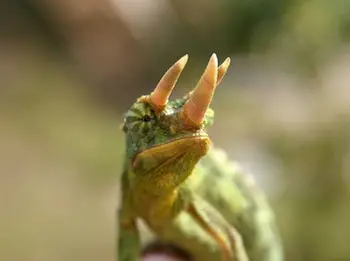
These African chameleons generally do very well in captivity, and I highly recommend starting with a juvenile, sub-adult, or adult, but not a baby. The babies can be tricky to raise. This is a live-bearing species so if you purchase a pair, you very well may end up with babies so do your research. I created a page dedicated to learning about baby chameleons that you may want to peruse!
They’ll consume any of the commonly available feeder insects, but crickets are their favorite, which coincidentally is what I feed all my chameleons. I recommend 1/2” to adult crickets as the staple food offering.
#2 - Veiled Chameleon (Chamaeleo calyptratus)
Veileds make absolutely awesome pet chameleons, although they aren’t necessarily for everyone. Let me explain. They’re almost always captive bred, which is a huge positive. They’re extraordinarily colorful, with greens, yellows, blues, browns, and white. Their appearance is unlike any other chameleon, namely because of their unusually tall head casque.
This species is an indiscriminate eater, consuming any insects you throw in its cage, although I primarily feed them crickets and roaches. Veiled chameleons are easy to breed, their babies are usually very strong, and they grow very quickly as well.
Some books say they can reach 24-inches in size, but I’ve never seen one anywhere near that large, and I’ve kept and bred thousands of them. I’d say 18-inches is about as big as you’re likely to see, which is a nice, solid size.
Veileds make absolutely awesome pet chameleons, although they aren’t necessarily for everyone. Let me explain. They’re almost always captive bred, which is a huge positive. They’re extraordinarily colorful, with greens, yellows, blues, browns, and white. Their appearance is unlike any other chameleon, namely because of their unusually tall head casque.
This species is an indiscriminate eater, consuming any insects you throw in its cage, although I primarily feed them crickets and roaches. Veiled chameleons are easy to breed, their babies are usually very strong, and they grow very quickly as well.
Some books say they can reach 24-inches in size, but I’ve never seen one anywhere near that large, and I’ve kept and bred thousands of them. I’d say 18-inches is about as big as you’re likely to see, which is a nice, solid size.
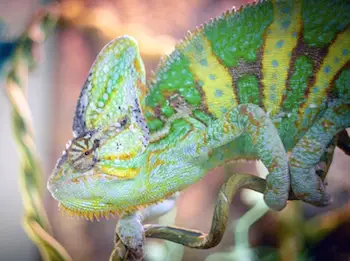
They’re endemic to the Middle East (see Wikipedia map to the left), namely Saudi Arabia and Yemen. Now, this is important because it explains why they’re so resistant to dehydration. Some chameleons just seem to require much less water than others, and I’d say Veileds and Oustalet’s are at the top of that list.
Veiled chameleons have long lifespans. In fact, the first chameleon I ever purchased was a baby male Veiled, and he’s grown into a beast—and that was over five years ago.
So, why aren’t they for everyone? It’s mainly because they generally don’t appreciate being handled. Now, please know that no chameleons like being handled, but some tolerate it better than others. Veiled chameleons are less tolerant. Also, if you don’t want to deal with eggs, but you want a pair—you’re out of luck, because they’re going to breed and she’s going to lay eggs.
#1 - Panther Chameleon (Furcifer pardalis)
Yes, I’ve saved the best for last. Panthers make the best pet chameleons in the world, in my humble opinion. They just seem to hit all the right buttons. They’re the single most stunningly beautiful chameleon in existence, bar none. I can’t even list all the colors they can achieve—I don’t even think they’ve all been described yet!
Anyone who comes into my facility is instantly in awe when they witness an adult Panther chameleon—they just can’t believe any animal could be so gorgeous—like a painting.
They’re almost always captive bred, which as I mentioned, is a huge advantage when it comes to chameleons. They’re also very good eaters, much like Veileds. I’ve also never been bit by a Panther—captive bred or imported—it just doesn’t seem to be their nature. Their activity level is great, and they don’t seem to mind interaction too much, although always keep it to a minimum.
Yes, I’ve saved the best for last. Panthers make the best pet chameleons in the world, in my humble opinion. They just seem to hit all the right buttons. They’re the single most stunningly beautiful chameleon in existence, bar none. I can’t even list all the colors they can achieve—I don’t even think they’ve all been described yet!
Anyone who comes into my facility is instantly in awe when they witness an adult Panther chameleon—they just can’t believe any animal could be so gorgeous—like a painting.
They’re almost always captive bred, which as I mentioned, is a huge advantage when it comes to chameleons. They’re also very good eaters, much like Veileds. I’ve also never been bit by a Panther—captive bred or imported—it just doesn’t seem to be their nature. Their activity level is great, and they don’t seem to mind interaction too much, although always keep it to a minimum.
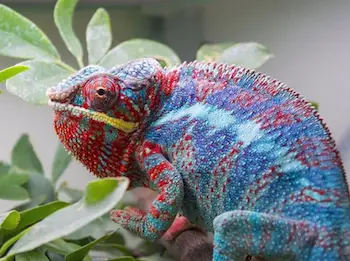
Panther chameleons can make a fun breeding project, although the babies can be a little more challenging to raise. Keep in mind, there’s a reason there are no mass Panther chameleon breeders out there, like there are for Veileds.
This species is usually described by its locale, which means the area of Madagascar from which it’s endemic. In other words, they’re usually named after the place where they were originally found. The most common would be Ambilobe, Nosy Be, Ambanja, Sambava, and Nosy Faly.
Each locale has its own very distinct coloration and patterning. Most locales are located within the northern tip of the island, as the range map to the left demonstrates.
Yes, you guess it—all of this comes at a price. Panther chameleons are usually one of the more expensive species, but well worth it in my opinion.
That completes my list of what I consider to be the top five best pet chameleons. I hope you now consider yourself more confident in your ability to select a species that will be a great fit for you and your home. You really can’t go wrong with any of the above chameleons. Remember to peruse my chameleon care sheet, which applies to all of the above chameleons.
